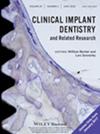Cortico-Cancellous Collagenic Porcine Bone for Alveolar Ridge Preservation: A Cohort Comparative Study
Abstract
Objectives
The primary aim of this study was to compare the histomorphometric characteristics of two different cortico-cancellous collagenic porcine bone (CCPB) formulations combined with a stabilizing agent used for alveolar ridge preservation (ARP), and the secondary aim was to evaluate and compare clinical and aesthetic outcomes of dental implants placed in augmented sites.
Materials and Methods
This was a prospective, cohort-comparative study conducted on patients requiring a tooth extraction followed by ARP and subsequent implant placement. Tooth extractions were performed trying to reduce the surgical trauma as much as possible, and then ARP was performed using two different formulations of CCPB combined with a thermogel in different ratios (50:50 hand-mixed and 80:20 pre-mixed). After 4 months of healing, implant placement was performed, and a bone biopsy was retrieved from the surgical site for histomorphometric analyses. Implants were rehabilitated 3 months following placement with screw-retained crowns, then patients were re-evaluated 1 year following prosthetic loading.
Results
We report the clinical and histomorphometric outcomes of 20 patients divided into the two study groups (10 patients per group). ARP performed with a hand-mixed biomaterial in a 50:50 ratio had higher percentages of newly formed bone (36.15% vs. 27.18%) when compared to a pre-mixed biomaterial in an 80:20 ratio, even though the difference was not statistically significant (p = 0.064). Implants placed in ARP-treated sites showed a very low mean marginal bone loss at the 1-year follow-up in both experimental groups (0.06 ± 0.15 mm in the 50:50 group and 0.25 ± 0.35 mm in the 80:20 group) with no statistically significant differences (p = 0.42), as well as the aesthetic outcomes assessed through the pink aesthetic score.
Conclusions
Both biomaterials showed effective and favorable outcomes, and the histomorphometric differences observed in our sample did not have any impact on the final clinical and aesthetic outcomes.

 求助内容:
求助内容: 应助结果提醒方式:
应助结果提醒方式:


